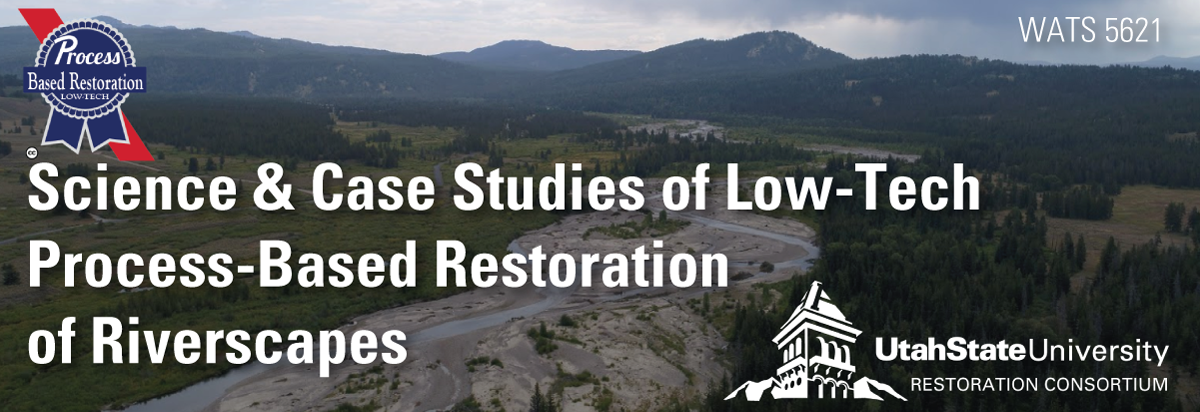WATS 5621 - Course Syllabus

Catalog Description
Students explore the science and case studies that encouraged Low-Tech Process-Based Restoration of Riverscapes (LTPBR). Students will examine key experiments and literature, gaining an understanding of both current knowledge and knowledge gaps in LTPBR science.
| Title | Science & Case Studies of Low-Tech Process-Based Restoration of Riverscapes |
|---|---|
| Semester Offered | Spring |
| Course Number | WATS 5621 |
| Credits | 1.0 Credit hour (1.5 CEU) |
| Level | Graduate / Undergraduate |
| Schedule | Hybrid face-to-face lecture |
| Cross-listed | CEWA 5621 |
← Back to Spring 2023 LTPBR Courses
Schedule
Spring 2023 - Science of LTPBR
- Matriculated Students: SCI&CASE STUD LOWTECH RIV - 16918 - WATS 5621
- Non-Matriculated Students: CEWA 5621
| Class | Time | Day | Location | Dates | Instructor |
|---|---|---|---|---|---|
| LTPBR Science & Case Studies | 1:30–3:30 pm MST | Tuesday | Zoom | Feb 21, 28 & Mar 14, 2023 | Nicolaas Bouwes |
Recurring Zoom link:
Join Zoom Meeting
Course Outline
Outline and assignments are posted in Canvas:
Canvas Course Page
Students are expected to complete readings and view pre-recorded lectures prior to class meetings, where discussion and exercises will occur.
| Meeting Date | Module | Topics |
|---|---|---|
| 2/21/2023 | 2.1 | Review & Introduction + Case Studies on Resilience |
| 2/28/2023 | 2.2 | Case Studies supporting LTPBR: Bridge Creek & Asotin Creek |
| 3/14/2023 | 2.3 | Current Science & Outstanding Knowledge Gaps |
This course is based on Module 2 from the self-paced workshop materials.
→ Access Module 2 Slides, Recordings, and Exercises
Fees
-
Matriculated Students: standard USU tuition rates for 1 credit
(typically $712–$2716 depending on level and residency)
Register on Banner -
Continuing Education Students: $315 (including CEU processing)
(Registration is closed for 2023)
Course Objectives
By the end of this course, students will:
- Identify the key scientific foundations for low-tech process-based restoration.
- Understand how confidence in LTPBR practices has been built through case studies of post-assisted log structures, beaver dam analogues, and similar approaches.
- Recognize where significant knowledge gaps remain.
Instructors
Lead Instructor
- Nicolaas Bouwes
Aquatic Ecologist, Adjunct Professor, Principal at Anabranch Solutions
Office hours: by appointment
Instructor Affiliations
Course Resources
Course resources (slides, exercises, and videos) are provided through Canvas:
Additionally, see:
Module 2 - Science Resources
Course Textbooks
Required Texts:
-
Low-Tech Process-Based Restoration of Riverscapes: Design Manual
Free PDF or Amazon / BookBaby -
Pocket Field Guide
Free PDF or purchase waterproof copy
Key Focus Chapters: 1 and 2
Grading
| Grade | Range |
|---|---|
| A | 93–100% |
| A- | 90–92.9% |
| B+ | 87–89.9% |
| B | 83–86.9% |
| B- | 80–82.9% |
| C+ | 77–79.9% |
| C | 73–76.9% |
| C- | 70–72.9% |
| D+ | 67–69.9% |
| D | 60–66.9% |
| F | below 60% |
University Policies
USU policies apply for:
- Attendance & Excused Absences
- Academic Integrity
- Student Conduct
- Academic Freedom
- Students with Disabilities
- Library Services
- Mental Health Resources
- Diversity, Inclusion, and Equity
- Title IX and Office of Equity
- Emergency Procedures
If you experience harassment, discrimination, or accessibility challenges, please contact the instructor or the USU Office of Equity.